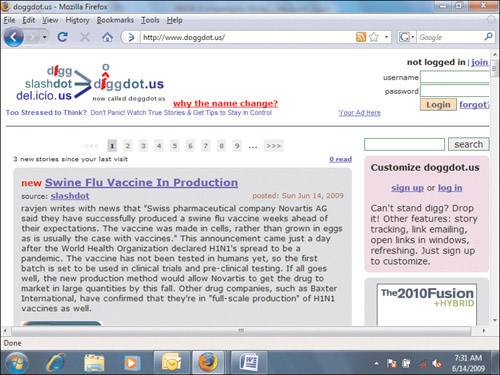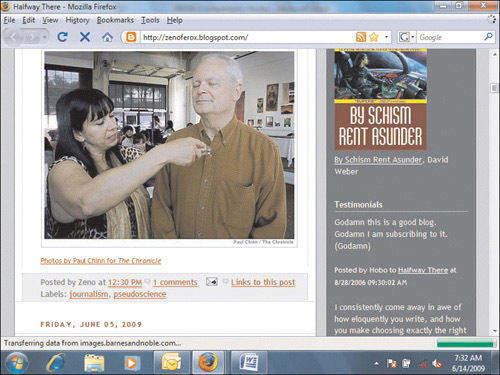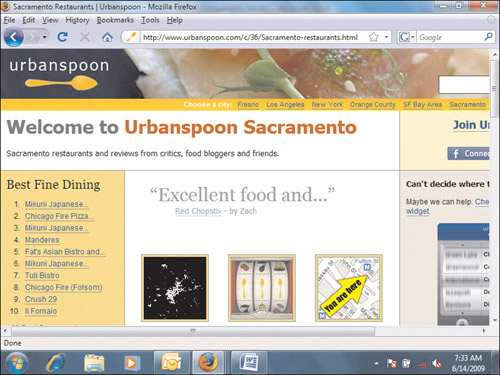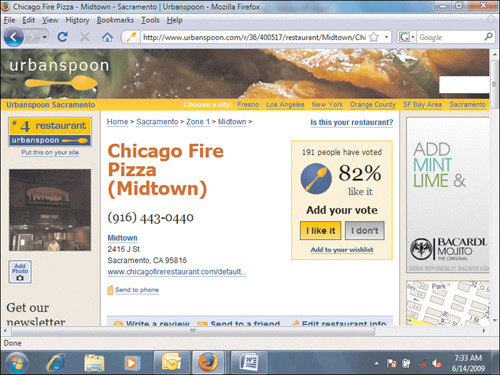9. Taking Advantage of Web 3.0 Blogs
An Overview of Web 3.0 Technologies
If you type “Web 3.0” into the Search box in your favorite search engine, you’ll find several definitions:
• The Web is becoming much more mobile as PDAs and cell phone functionality merge and include access to the Internet, social networking, and anything else the user wants to do at home, according to a May 2009 research report from Forrester Research (http://www.mobilemarketer.com/cms/news/research/3275.html). Apple’s iPhone and Palm’s Pre are just two of the latest mobile handsets that offer fast Internet connectivity no matter where you are.
• Tim Berners-Lee, director of the World Wide Web Consortium (and inventor of the Internet) described the Semantic Web (Web 3.0) as becoming “capable of analyzing all data on the Web—the content, links, and transactions between people and computers” (http://en.wikipedia.org/wiki/Semantic_Web). Berners-Lee believes that the Semantic Web will take advantage of “intelligent agents” that are autonomous entities and direct its activity toward achieving goals (http://en.wikipedia.org/wiki/Intelligent_agent). In the case of the Semantic Web, intelligent agents will crawl through the Web in response to complex questions. For example, if I want to go to a performance of the San Francisco Opera and then go to a Moroccan restaurant in the city for dinner afterward, I can ask a complex question such as “What is the next performance of the San Francisco Opera and where can I find a good Moroccan restaurant to eat afterward?” The Web will take that information and organize richer results for me than what is available today.
• The Web will become more personalized to your needs. You’re probably used to shopping sites such as Amazon.com learning about your past purchases and offering suggestions based on those purchases the next time you shop on their site. In a Web 3.0 world, your browser will learn over time what your preferences are and will tailor your browsing experiences to your preferences. What’s more, everyone’s browsing experience will be different even when they go to the same URL. The Amazon.com Web site already does this to some degree. When you visit Amazon.com, the site uses browser cookies to determine what you looked at last time you visited so that it can promote related products that you may like.
So with all this in mind, what technologies are being used right now that are forerunners of Web 3.0 technologies to come? We’ll take a look at two: Wikipedia and widgets.
Wikipedia
You’ve probably heard of wiki Web sites. The term wiki means “fast” in Hawaiian, but in the Web world it means a Web site that has a number of interlinking pages that are managed using a relational database system. The pages are Spartan in looks but quick to load, and people can add and edit entries within the wiki system.
There are plenty of wiki sites available on the Web, and you can download and establish your own wiki on your own Web site. An example of the former is the popular Wikipedia site (http://www.wikipedia.org), which is a free online encyclopedia maintained by users. You can get a lot of information on Wikipedia that you might not be able to get anyplace else, such as a comparison of wiki software, as shown in Figure 9.1.
Figure 9.1 The Wikipedia Web site page that compares wiki software packages.

Wikis have been around since the mid-1990s, but only recently have companies started to leverage wiki technologies, along with developing Web 3.0 technologies to make data exchange more accessible to businesses. For example, the Swirrl Web site (http://www.swirrl.com) shown in Figure 9.2 is staking an early claim on being a Web 3.0 company.
Figure 9.2 The Swirrl Web site.

Swirrl leverages the Semantic Web technology called Linked Data, which is the recommended best practice for exposing and linking data on the Web. (If you want to see an example of how it works and to get more information, go to the Linked Data Web site at http://linkeddata.org/.) Using Linked Data, Swirrl maintains your data online so that people can log in using a modern Web browser, add information akin to a wiki, and microblog to other people in the business or project team. Swirrl has positioned itself to businesses as a service using tools that are familiar, easy to use, and easy to access.
APIs and Widgets
Some Web 2.0 platforms currently in use may be the springboard for Web 3.0 technologies. For example, many social networking sites, including LinkedIn and Facebook, offer application programming interfaces (APIs) to developers so that they can create applications using those sites’ unique resources. For example, LinkedIn has an application that links to a person’s WordPress blog.
Modern operating systems such as Mac OS X and Windows 7, as well as mobile computing platforms like the iPhone, have established small applications called widgets. Widgets can also be small applications that link to an object, such as a few lines of HTML code from YouTube that you place in a blog post to show a video presentation you gave recently. A good place to find a comprehensive list of widgets for the desktop, the Web, and your mobile device is the Widgipedia Web site (http://www.widgipedia.com) shown in Figure 9.3.
Figure 9.3 The Widgipedia Web site.

So what does this mean for your business if you’re trying to reach your customers? First, you might be able to find an application available that you can use to enhance your blog, link to your Web site, and link to your social networking sites at little or no charge. What’s more, developers are working to “mash up” applications to make them more usable and relevant.
Mash It Up!
The term mash up (also sometimes styled as mashup, but we call it mash up throughout this book for consistency) means to combine one or more applications into a single application. You might have seen an example of this on a business site (or perhaps your own business site) that lets visitors check Google Maps to see where a company is located. That’s a basic example. If you want to see more interesting mash ups, look at the Webmashup.com site shown in Figure 9.4.
On this site, you can view more than 200 examples of how people combine applications into a new one. For example, one site combines the news resources of Digg, Slashdot, and del.icio.us to form doggdot.us, as shown in Figure 9.5.
Figure 9.4 The Webmashup.com Web site.

Figure 9.5 The Doggdot.us Web site.

This site originally included parts of the three sites it combined, but it had to change its name because of copyright issues Digg’s lawyers brought to the Doggdot.us owner’s attention. The cautionary note here if you have developers and you want to create your own mash up applications (such as a blog with another application) is to make sure it doesn’t interfere, or give the appearance of interfering, with another company’s trademarks.
There is speculation that in the future you may be able to drag and drop different programs into a Web page and have the combined application work flawlessly. For example, you could drop Google Maps and several local business and newspaper Web sites so that you can see where companies are currently building. No one has figured out how to do this as of this writing, but developers are thinking about it.
Integrating Semantic Technologies
The Semantic Web requires that ontologies, or files that define the relationships between groups of terms, be detailed and comprehensive so that the Web can find richer search results for you. The translation of “detailed and comprehensive” is a lot of work, and there’s debate about whether people will be interested in putting in the work to make their Web sites as searchable as possible.
On the other hand, blogs, photoblogs, and vlogs all allow you to add tags so that you can categorize your blogs. For example, in the Halfway There blog, shown in Figure 9.6, the Blogger Web site allows you to add category tags at the bottom of the post. In this example, if you click the Journalism category tag, you’ll see all posts that also have that tag.
Figure 9.6 The Halfway There blog with the Journalism category tag.

If you’re interested in integrating semantic technologies into your blog right away, blog software and sites have these tagging features so that you can add posts to one or more categories, add a category list to your blog, and make reading a little easier for people who are interested in specific topics.
Make Agents Work for Your Blog
So how do you make your Web site available to the Semantic Web and get your business ahead of the Web 3.0 curve? A company in Ireland has developed a search engine that will help get your blog and your Web site noticed, as long as you have a developer on board (or would like to program it yourself).
The Digital Enterprise Research Institute (DERI) of Galway, Ireland, has created the Sindice Semantic Web search engine at http://www.sindice.com (see Figure 9.7).
Figure 9.7 The Sindice Web site.

This site not only lets you search Web sites that have the Semantic Web language framework called Resource Description Framework, or RDF, but that also use Sindice APIs and widgets to integrate into your blog and other applications.
The good news is that when your Webmaster submits your blog (and even your Web site) to Sindice, the site will be indexed within an hour. So, people searching for your site will be able to find it even more quickly.
The bad news is that as of this writing Sindice is still in early beta form, and if people want to check you out on the Semantic Web, they need to visit the Sindice Web site. Even so, if you want your blog and any other Web assets to be on the cutting edge, consider making the Sindice agents work for you.
Case Study: UrbanSpoon.com
If you’re looking for a place to eat in a metropolitan area near you, the UrbanSpoon.com Web site is a good place to get comprehensive information about restaurants in the area. UrbanSpoon.com, shown in Figure 9.8, is also a good example of using mash ups to create an early-generation Web 3.0 site.
Figure 9.8 The UrbanSpoon.com Web site Sacramento listings.

The site in this example is for the Sacramento area; however, you can choose another city at the top of the page or search for a particular term. The site has a number of different category lists from the top 10 rated restaurants overall, popular restaurants with readers who rate the restaurants, types of food, neighborhoods, features, price, and more.
Part of that “more” includes a widget that lets you select a restaurant at random in the Sacramento area if you don’t know where to go, and you can put this widget on your own blog or Web site. The home page also mashes up information from local newspaper critics and local bloggers.
If you click a restaurant to check it out, you’ll see a number of Web 2.0 and 3.0 features. In Figure 9.9, the Chicago Fire Pizza page on UrbanSpoon lets you interact with the listing in a number of ways.
Figure 9.9 The Chicago Fire Pizza listing on UrbanSpoon.com.

You can write a review, view the menu, and read critic, blogger, and other user reviews. If you want to know where the restaurant is, the Google map will tell you where it is. You can also get driving directions, see nearby restaurants, and even see other pizza places if you decide Chicago Fire is not to your liking.
If you scroll down to the bottom of the page, you’ll see a link to another Web 3.0 feature: the UrbanSpoon application for the iPhone. Of course, UrbanSpoon doesn’t just use the iPhone; you can also get UrbanSpoon on your mobile phone. After you enter your phone number and choose your carrier, you send the number to your phone and then receive a text link.
The bottom of the page also has a link to the UrbanSpoon blog, where you can get more information about what’s going on with UrbanSpoon and view food blogs by metro region.
Although there is a lot of information on UrbanSpoon.com, the ready availability of that information no matter where you are makes UrbanSpoon a good example of leveraging Web 2.0 and 3.0 technologies to give customers what they need.
Summary
The second decade of the 21st century is here, and Web 3.0 technologies are coming with it. There are several different technologies that comprise the Web 3.0 definition including mobile devices, the Semantic Web that will use intelligent agents to achieve goals, and a Web much more personalized to your needs.
This chapter looked at different technologies and techniques being used that are signs of Web 3.0 technologies to come, including APIs, widgets, mashups, and adding tags to your blog. The UrbanSpoon Web site is a good example of how to use them.
Hopefully you now have enough ideas in your head to create or improve your blog so it will drive business to your company. If you want to chat with us and ask us questions, feel free to visit our Web site at www.blogging2drivebiz.com.
